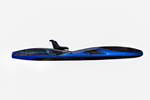Mito Materials graphene amplify composite fly fishing rod performance
Functionalized graphene addition to premium-performance Evos and Evos Salt fly rods by St. Croix Fly enables faster recovery, increased torsional rigidity and improved strength-to-weight ratios.
Evos fly fishing rod. Photo Credit: St. Croix Fly
(Park Falls, Wis., U.S.), a company that has developed and manufactured fly fishing rods throughout its 75-year history, is unveiling Evo and its saltwater-equivalent, Evo Salt, two new premium fly rod designs that have been further refined using Mito Material Solution’s (Indianapolis, Ind., U.S.) graphene technology.
Many of St. Croix’s conventional (non-fly) rods are constructed from SCIII+, a hybrid carbon fiber material combining high modulus, high-strain SCIII carbon fiber and super high modulus SCVI exotic carbon fiber. The Evo and Evos Salt Series fly rods are constructed from ultra-high modulus/high-strain SCVI carbon, high-modulus SCIV carbon and premium-quality SCII carbon.
Unlike other fly rods built with pre-applied graphene integrated into carbon fiber prepreg, Evos and Evos Salt are powered by Mito’s functionalized graphene, which is applied in-house at St. Croix at total weight-loading accuracies within 0.01%, delivering radical hoop strength, optimized loop stability and complete accuracy. The process also fits within St. Croix’s vertical-control philosophy, affords extreme consistency and ultimately delivers anglers with more of the benefits graphene can provide — namely faster recovery, increased torsional rigidity and improved strength-to-weight ratios.
St. Croix also says the use of integrated poly curve (IPC) mandrel tooling provides improved energy transfer, increased strength and efficient rod recovery; advanced reinforcing technology (ART) adding 10 times more strength with virtually no increase in blank diameter or weight; a fortified resin system (FRS) boosts blank strength by 33% over standard resins and curing methods; and a reinforced slim profile ferrule (SPF) design adds strength with minimal added weight.
Evos is said to challenge the status quo of traditional fly-rod design and sets the bar for multi-technique. The rod consists of 14 four-piece models ranging from line sizes #4 through #8. Similarly, Evos Salt optimizes angler ability by delivering critical control in any saltwater environment. It is available in seven four-piece models covering #6 through #12 line sizes. Overall, both series offer their user a wide range of casting distances, high accuracy and a balance between punch and precision.
Related Content
-
Composites end markets: Batteries and fuel cells (2024)
As the number of battery and fuel cell electric vehicles (EVs) grows, so do the opportunities for composites in battery enclosures and components for fuel cells.
-
Mito to introduce graphene to EV energy storage innovations
Project initiatives for a multifunctional adhesive and addressing EV battery challenges are expected to change the dynamics of energy storage adoption.
-
Cygnet, Viritech recover H2 tank continuous carbon fibers in Ford FCVGen2.0 project
Partner technologies have demonstrated the viability of recycled continuous fibers and the potential for automotive tanks to be recycled at meaningful rates.






